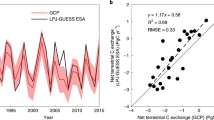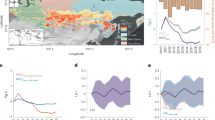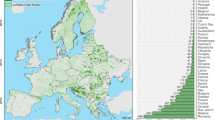Abstract
Changes in terrestrial carbon storage under environmental and land-use changes remain a critical source of uncertainty in regional and global carbon budgets. We generated global maps of annual live vegetation biomass using L-band microwave vegetation optical depth. Globally, biomass carbon stocks increased from 2010 to 2019 at a rate of 0.50 ± 0.20 PgC yr−1 with a year-to-year variability, closely mirroring the observations of the global atmospheric CO2 growth rate. The main contributors to the global carbon sink are boreal and temperate forests, while wet tropical forests are small carbon sources, from deforestation and agriculture-related disturbances. We found that the tropical deforested and degraded old-growth forests (>140 yr) are nearly carbon neutral whereas temperate and boreal young (< 50 yr) and middle-aged (50–140 yr) forests are the largest sinks. By contrast, dynamic global vegetation models show that all old-growth forests are large sinks and largely ignore the impacts of deforestation and degradation on tropical biomass. Our findings highlight the importance of forest demography when predicting dynamics of future carbon sink under changing climate.
This is a preview of subscription content, access via your institution
Access options
Access Nature and 54 other Nature Portfolio journals
Get Nature+, our best-value online-access subscription
$29.99 / 30 days
cancel any time
Subscribe to this journal
Receive 12 print issues and online access
$259.00 per year
only $21.58 per issue
Buy this article
- Purchase on Springer Link
- Instant access to full article PDF
Prices may be subject to local taxes which are calculated during checkout




Similar content being viewed by others
Data availability
The L-VOD data from this study can be accessed freely through the SMOS-IC website (https://ib.remote-sensing.inrae.fr/). The global forest change product can be accessed from https://earthenginepartners.appspot.com/science-2013-global-forest/download_v1.7.html. The forest disturbance classification map is freely available from https://www.science.org/doi/10.1126/science.aau3445. The forest age datasets are freely available at https://doi.org/10.17871/ForestAgeBGI.2021. The simulations from TRENDY DGVMs are available at https://sites.exeter.ac.uk/trendy.
Code availability
All computer codes for the analysis of the data are available from the corresponding author on reasonable request.
References
Friedlingstein, P. et al. Global carbon budget 2019. Earth Syst. Sci. Data 11, 1783–1838 (2020).
Pan, Y. et al. A large and persistent carbon sink in the world’s forests. Science 333, 988–993 (2011).
Ciais, P. et al. Empirical estimates of regional carbon budgets imply reduced global soil heterotrophic respiration. Natl Sci. Rev. 8, nwaa145 (2021).
Ballantyne, A. P., Alden, C. B., Miller, J. B., Tans, P. P. & White, J. W. C. Increase in observed net carbon dioxide uptake by land and oceans during the past 50 years. Nature 488, 70–72 (2012).
Harris, N. L. et al. Global maps of twenty-first century forest carbon fluxes. Nat. Clim. Change 11, 234–240 (2021).
Xu, L. et al. Changes in global terrestrial live biomass over the 21st century. Sci. Adv. 7, eabe9829 (2021).
Grassi, G. et al. The key role of forests in meeting climate targets requires science for credible mitigation. Nat. Clim. Change 7, 220–226 (2017).
Hubau, W. et al. Asynchronous carbon sink saturation in African and Amazonian tropical forests. Nature 579, 80–87 (2020).
Tagesson, T. et al. Recent divergence in the contributions of tropical and boreal forests to the terrestrial carbon sink. Nat. Ecol. Evol. 4, 202–209 (2020).
Tubiello, F. N. et al. Carbon emissions and removals from forests: new estimates, 1990–2020. Earth Syst. Sci. Data 13, 1681–1691 (2021).
Chen, Z. et al. Linking global terrestrial CO2 fluxes and environmental drivers: inferences from the Orbiting Carbon Observatory 2 satellite and terrestrial biospheric models. Atmos. Chem. Phys. 21, 6663–6680 (2021).
Deng, Z. et al. Comparing national greenhouse gas budgets reported in UNFCCC inventories against atmospheric inversions. Earth Syst. Sci. Data 14, 1639–1675 (2022).
Bastos, A. et al. Sources of uncertainty in regional and global terrestrial CO2 exchange estimates. Glob. Biogeochem. Cycles 34, e2019GB006393 (2020).
Rodríguez-Fernández, N. J. et al. An evaluation of SMOS L-band vegetation optical depth (L-VOD) data sets: high sensitivity of L-VOD to above-ground biomass in Africa. Biogeosciences 15, 4627–4645 (2018).
Li, X. et al. Global-scale assessment and inter-comparison of recently developed/reprocessed microwave satellite vegetation optical depth products. Remote Sens. Environ. 253, 112208 (2021).
Fan, L. et al. Satellite-observed pantropical carbon dynamics. Nat. Plants 5, 944–951 (2019).
Yang, H. et al. Climatic and biotic factors influencing regional declines and recovery of tropical forest biomass from the 2015/16 El Niño. Proc. Natl Acad. Sci. USA 119, e2101388119 (2022).
Oliva, R. et al. Status of radio frequency interference (RFI) in the 1400–1427 MHz passive band based on six years of SMOS mission. Remote Sens. Environ. 180, 64–75 (2016).
Konings, A. G., Rao, K. & Steele-Dunne, S. C. Macro to micro: microwave remote sensing of plant water content for physiology and ecology. N. Phytol. 223, 1166–1172 (2019).
Gatti, L. V. et al. Amazonia as a carbon source linked to deforestation and climate change. Nature 595, 388–393 (2021).
Liu, Y. Y. et al. Recent reversal in loss of global terrestrial biomass. Nat. Clim. Change 5, 470–474 (2015).
Hansen, M. C. et al. High-resolution global maps of 21st-century forest cover change. Science 342, 850–853 (2013).
Venter, Z. S., Cramer, M. D. & Hawkins, H. J. Drivers of woody plant encroachment over Africa. Nat. Commun. 9, 2272 (2018).
Liu, Y. Y., De Jeu, R. A., McCabe, M. F., Evans, J. P. & Van Dijk, A. I. Global long‐term passive microwave satellite‐based retrievals of vegetation optical depth. Geophys. Res. Lett. 38, L18402 (2011).
Gasser, T. et al. Historical CO2 emissions from land use and land cover change and their uncertainty. Biogeosciences 17, 4075–4101 (2020).
Brandt, M. et al. Reduction of tree cover in West African woodlands and promotion in semi-arid farmlands. Nat. Geosci. 11, 328–333 (2018).
Tong, X. et al. Forest management in southern China generates short term extensive carbon sequestration. Nat. Commun. 11, 129 (2020).
Guillaume, T. et al. Carbon costs and benefits of Indonesian rainforest conversion to plantations. Nat. Commun. 9, 2388 (2018).
Goll, D. S., Joetzjer, E., Huang, M. & Ciais, P. Low phosphorus availability decreases susceptibility of tropical primary productivity to droughts. Geophys. Res. Lett. 45, 8231–8240 (2018).
Pugh, T. A., Arneth, A., Kautz, M., Poulter, B. & Smith, B. Important role of forest disturbances in the global biomass turnover and carbon sinks. Nat. Geosci. 12, 730–735 (2019).
Yang, H. et al. Comparison of forest above-ground biomass from dynamic global vegetation models with spatially explicit remotely sensed observation-based estimates. Glob. Change Biol. 26, 3997–4012 (2020).
Besnard, S. et al. Mapping global forest age from forest inventories, biomass and climate data. Earth Syst. Sci. Data 13, 4881–4896 (2021).
Phillips, O. L. & Brienen, R. J. Carbon uptake by mature Amazon forests has mitigated Amazon nations’ carbon emissions. Carbon Balance Manage. 12, 1 (2017).
Matricardi, E. A. T. et al. Long-term forest degradation surpasses deforestation in the Brazilian Amazon. Science 369, 1378–1382 (2020).
Maxwell, S. L. et al. Degradation and forgone removals increase the carbon impact of intact forest loss by 626%. Sci. Adv. 5, eaax2546 (2019).
Luyssaert, S. et al. Old-growth forests as global carbon sinks. Nature 455, 213–215 (2008).
Lang, N. et al. Global canopy height regression and uncertainty estimation from GEDI LIDAR waveforms with deep ensembles. Remote Sens. Environ. 268, 112760 (2022).
Pugh, T. A. et al. Role of forest regrowth in global carbon sink dynamics. Proc. Natl Acad. Sci. USA 116, 4382–4387 (2019).
Palace, M., Keller, M., Hurtt, G. & Frolking, S. in Tropical Forests (eds Sudarshana, P. et al.) 215–252 (InTech Open, 2012).
Yang, H. et al. Coarse woody debris are buffering mortality-induced carbon losses to the atmosphere in tropical forests. Environ. Res. Lett. 16, 011006 (2021).
Browne, L. et al. Increased mortality of tropical tree seedlings during the extreme 2015–16 El Niño. Glob. Change Biol. 27, 5043–5053 (2021).
Orth, R., Zscheischler, J. & Seneviratne, S. I. Record dry summer in 2015 challenges precipitation projections in Central Europe. Sci. Rep. 6, 28334 (2016).
Marengo, J. A. et al. Two contrasting severe seasonal extremes in tropical South America in 2012: flood in Amazonia and drought in northeast Brazil. J. Clim. 26, 9137–9154 (2013).
Baranowski, K., Faust, C. L., Eby, P. & Bharti, N. Quantifying the impacts of Australian bushfires on native forests and gray-headed flying foxes. Glob. Ecol. Conserv. 27, e01566 (2021).
Wolf, S. et al. Warm spring reduced carbon cycle impact of the 2012 US summer drought. Proc. Natl Acad. Sci. USA 113, 5880–5885 (2016).
Konings, A. G., Holtzman, N. M., Rao, K., Xu, L. & Saatchi, S. S. Interannual variations of vegetation optical depth are due to both water stress and biomass changes. Geophys. Res. Lett. 48, e2021GL095267 (2021).
Brandt, M. et al. Satellite passive microwaves reveal recent climate-induced carbon losses in African drylands. Nat. Ecol. Evol. 2, 827–835 (2018).
Wigneron, J. P. et al. Tropical forests did not recover from the strong 2015–2016 El Niño event. Sci. Adv. 6, eaay4603 (2020).
Tootchi, A., Jost, A. & Ducharne, A. Multi-source global wetland maps combining surface water imagery and groundwater constraints. Earth Syst. Sci. Data 11, 189–220 (2019).
Melton, J. R. et al. A map of global peatland extent created using machine learning (Peat-ML). Geosci. Model Dev. 15, 4709–4738 (2022).
Thoning, K. W., Tans, P. P. & Komhyr, W. D. Atmospheric carbon dioxide at Mauna Loa Observatory: 2. Analysis of the NOAA GMCC data, 1974–1985. J. Geophys. Res. Atmos. 94, 8549–8565 (1989).
Saatchi, S. S. et al. Benchmark map of forest carbon stocks in tropical regions across three continents. Proc. Natl Acad. Sci. USA 108, 9899–9904 (2011).
Avitabile, V. et al. An integrated pan-tropical biomass map using multiple reference datasets. Glob. Change Biol. 22, 1406–1420 (2016).
Baccini, A. G. S. J. et al. Estimated carbon dioxide emissions from tropical deforestation improved by carbon-density maps. Nat. Clim. Change 2, 182–185 (2012).
Santoro, M. et al. A detailed portrait of the forest aboveground biomass pool for the year 2010 obtained from multiple remote sensing observations. Geophys. Res. Abstr. 20, EGU2018–EGU18932 (2018).
Spawn, S. A., Sullivan, C. C., Lark, T. J. & Gibbs, H. K. Harmonized global maps of above and belowground biomass carbon density in the year 2010. Sci. Data 7, 112 (2020).
Chevallier, F. et al. Objective evaluation of surface- and satellite-driven carbon dioxide atmospheric inversions. Atmos. Chem. Phys. 19, 14233–14251 (2019).
Wernick, I. K. et al. Quantifying forest change in the European Union. Nature 592, E13–E14 (2021).
Curtis, P. G., Slay, C. M., Harris, N. L., Tyukavina, A. & Hansen, M. C. Classifying drivers of global forest loss. Science 361, 1108–1111 (2018).
Hurtt, G. C. et al. Harmonization of land-use scenarios for the period 1500–2100: 600 years of global gridded annual land-use transitions, wood harvest, and resulting secondary lands. Climatic Change 109, 117–161 (2011).
Acknowledgements
This research has been funded by the European Space Agency Climate Change Initiative (ESA-CCI) Biomass project (ESA ESRIN/ 4000123662) and RECCAP2 project 1190 (ESA ESRIN/ 4000123002/18/I-NB). H.Y. was supported by the CCI Biomass project of the Climate Change Initiative (ESA ESRIN/ 4000123662) funded by ESA and the Project Office BIOMASS (grant number 50EE1904) funded by the German Federal Ministry of Economics and Technology. J.-P.W. acknowledges support from the CNES (Centre National d’Etudes Spatiales) TOSCA programme. L.F. acknowledges support from the National Natural Science Foundation of China (Grant No. 42171339).
Author information
Authors and Affiliations
Contributions
P.C., J-P.W. and H.Y. designed the research. H.Y. performed all of the analyses. F.F., X.L. and J-P.W. prepared the raw SMOS-IC L-VOD data. S. Besnard prepared the forest age product. Z.D. prepared the national inventory data. H.Y., J.-P.W., P.C., M.B., R.F., S.S., L.F. and S. Bowring interpreted the results and provided comments on the discussion. The manuscript was drafted by H.Y., J.-P.W, and P.C. with contributions by all co-authors.
Corresponding author
Ethics declarations
Competing interests
The authors declare no competing interests.
Peer review
Peer review information
Nature Geoscience thanks David Chaparro and the other, anonymous, reviewer(s) for their contribution to the peer review of this work. Primary Handling Editor: Xujia Jiang, in collaboration with the Nature Geoscience team.
Additional information
Publisher’s note Springer Nature remains neutral with regard to jurisdictional claims in published maps and institutional affiliations.
Extended data
Extended Data Fig. 1 Comparison with the results of an Amazon inversion study.
(a) The right-hand side panel shows the air samples collected at the four sites influenced by the regions (light blue lines). The left-hand side panel is a comparison of the average of total carbon flux for four sites from Gatti et al. (ref. 20) and the average of total biomass changes from L-VOD for the influence regions of four sites. Error-bars of carbon flux are uncertainties related to the background and travel time trajectories for each sample used to compose first the monthly mean and later the annual means, while error-bars of ∆TB are the standard deviation of total biomass changes from L-VOD for the influence regions. (b) L-VOD derived mean annual changes in total live biomass carbon density over 2010-2019. (c) Mean annual changes in total live biomass carbon density over 2010-2019 (data from ref. 6). (d) Total forest gross loss fraction over 2010-2019 using the Landsat-based Global Forest Change Data. Panel a reproduced with permission from ref. 20, Springer Nature Limited.
Extended Data Fig. 2 The fraction of zero/minor loss, deforestation, agriculture, forestry, wildfire, and urbanization.
The fraction of zero/minor loss (a), deforestation (b), agriculture (c), forestry (d), wildfire (e), and urbanization (f) with a spatial resolution of 25 ×25 km, aggregated from the forest disturbance map by Curtis et al. (ref. 59).
Extended Data Fig. 3 Changes in forest fraction from 2010 to 2018 from the TRENDY model ensembles.
The fraction of forest for each year was calculated using plant functional type fractions from each DGVM.
Extended Data Fig. 4 Changes in ∆TB density from L-VOD and from TRENDY DGVMs partitioned to different classes of canopy height (2 m intervals).
The averaged changes in total live biomass (∆TB) density from L-VOD (a) and from TRENDY DGVMs (b) during 2010-2019 partitioned to different classes of forest ages (20-year intervals). The width of colored bars represents the forest area of different forest classes. The total ∆TB density of intact forests is shown as white bars (the width of white bars represents the area of intact forests) in panel a.
Extended Data Fig. 5 Relationship between total live biomass changes from each TRENDY DGVM and forest age.
The averaged changes in total live biomass (∆TB) density during 2010-2019 partitioned to different classes of forest ages (20-year intervals). Total ∆TB density in each class area TRENDY DGVMs. The width of colored bars represents the forest area of different forest classes.
Extended Data Fig. 6 Global patterns of carbon fluxes for the year of 2012 and 2015.
The carbon fluxes, which are the loss or gains in total live biomass within one year, are calculated using the difference in L-VOD derived live biomass between year n and year n + 1.
Extended Data Fig. 7 Interannual variability of regional carbon fluxes from L-VOD without and with coarse woody debris (CWD) buffering over 2012 – 2019.
The regional carbon fluxes were calculated for five biomes, that is, wet tropics, dry tropics, arid, temperate and boreal. Panel a displays the interannual variability without CWD buffering, while panel b presents the interannual variability with CWD buffering.
Extended Data Fig. 8 Mean annual changes in above-ground biomass carbon density over 2010-2019.
(a) The annual values of live biomass were calculated as the averages of November, December, January and February (that is, Jan 1-centered averages). (b) The annual values of live biomass were calculated as the averages of May, June, July, and August (that is, July 1-centered averages). (c) Difference in AGB change between Jan 1-centered averages and July 1-centered averages.
Extended Data Fig. 9 Mean net biome productivity for global and five climatic biomes.
Mean values of annual net biome productivity (NBP) are estimated using two inversion models (SURF, and GOSAT), and pink bars presents the adjusted NBP estimates using the river-to-estuary carbon flux and crop & wood carbon productions from Deng et al. (2021) (ref. 12 see Supplementary Table S3). NBP were calculated for global (a), and five climatic biomes: wet tropics (b), dry tropics (c), arid (d), temperate (e), and boreal (f). The error-bars denote the standard deviation of annual NBP over the periods (2010-2018 for SURF and 2010-2015 for GOSAT).
Supplementary information
Supplementary Information
Supplementary Figs. 1–11, Tables 1–3 and Texts 1–4.
Rights and permissions
Springer Nature or its licensor (e.g. a society or other partner) holds exclusive rights to this article under a publishing agreement with the author(s) or other rightsholder(s); author self-archiving of the accepted manuscript version of this article is solely governed by the terms of such publishing agreement and applicable law.
About this article
Cite this article
Yang, H., Ciais, P., Frappart, F. et al. Global increase in biomass carbon stock dominated by growth of northern young forests over past decade. Nat. Geosci. 16, 886–892 (2023). https://doi.org/10.1038/s41561-023-01274-4
Received:
Accepted:
Published:
Issue Date:
DOI: https://doi.org/10.1038/s41561-023-01274-4
This article is cited by
-
Soil Carbon Mineralization and Aggregate Distribution in Various Tillage Practices of Rice–Wheat Cropping System: A Field and Laboratory Study
Journal of Soil Science and Plant Nutrition (2024)



